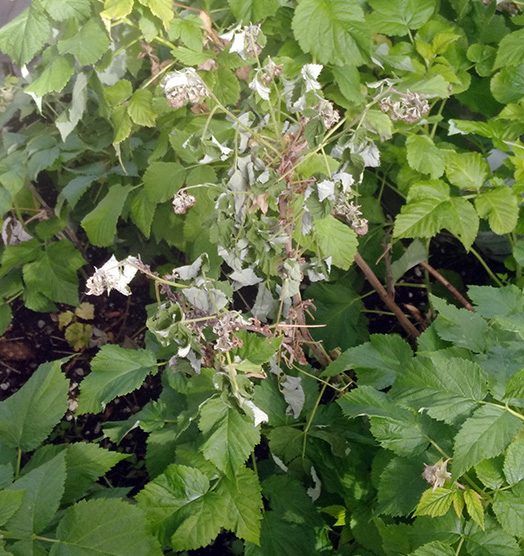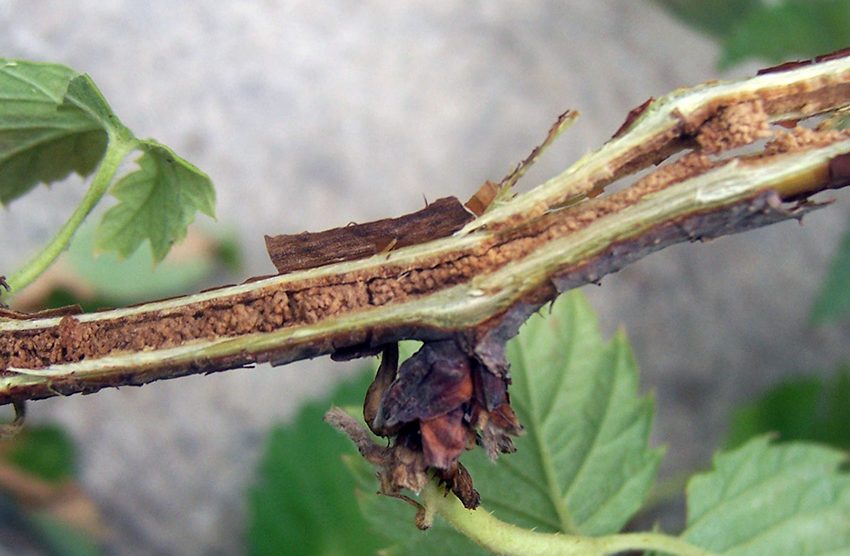In this Issue
- Codling moth: updated spray dates table
- San Jose scale: treat crawlers now
- Peach twig borer: updated spray dates table
- Greater peachtree borer: treatment time in next few weeks
- Western cherry fruit fly: treatment should start when fruits turn salmon blush color
- Rose stem girdler: treat canes now
APPLE, PEAR
Codling Moth
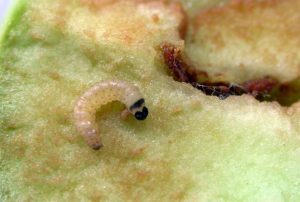
View a pdf of the spray timing table. Many areas are entering a time period where 75% of first-generation eggs will hatch over approximately 2 weeks. If you are late on the spray, or want to spray at the bare minimum, focus on keeping fruit protected during this timing.
Treatment
- See this post for spray options for backyard growers (scroll down to Codling Moth heading and see table).
- Options for commercial growers.
San Jose Scale
Time to treat crawlers now
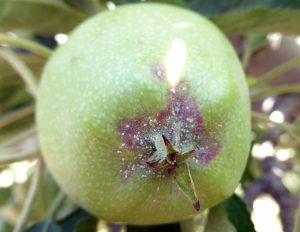
San Jose scale is an armored scale (immobile insect with hard covering) that mostly occurs on apple. It can be found feeding on bark, and when populations are high, it appears on fruit as small pepper-flake spots with a purple halo. The scales are often difficult to see with the naked eye and require magnification.
We always recommend a dormant oil spray, and this helps to knock down the scale population but does not control it. The oil only smothers the overwintering nymphs, whose protective “covering” is not as developed as adults. Overwintering adults will survive the dormant oil spray, and offspring laid by females (called crawlers) will need to be treated. Crawlers walk or are windblown to new sites to settle on twigs or fruit, insert their mouthparts, and feed for the remainder of their lives.
- Cache, Carbon, Iron, Summit, Uinta, Wasatch counties: June 9 – 13
- Wasatch Front and Sevier County: June 3 – 5
- Sanpete County: June 13 – 17
- Grand county (Moab), second generation: July 6 – 8
Treatment
- Backyard growers can use insecticidal soap plus 1% oil, neem oil, GardenTech Sevin plus 1% oil, or Spectracide Triazicide. In addition, the trunk can be scrubbed to remove the scale bodies (best done in fall or spring).
- Options for commercial growers: click here.
PEACH/NECTARINE, APRICOT, PLUM
Peach Twig Borer
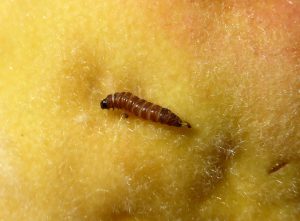
Dates are provided for several additional sites for protection of shoots and fruit against peach twig borer.
Peach twig borer larvae prefer to feed inside leaf shoots. Later in the season, when twigs become hardened off and unpalatable, larvae enter fruit as the “second best option.” In short, the first generation bores into succulent twigs (hence, its name) while later generations move on to the ripening fruit.
Treatment options are the same as for codling moth (scroll down to the table in this April 10 post).
Greater Peachtree Borer
Treat trunks of peach, plum in the next few weeks.
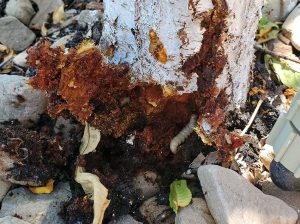
Greater peachtree borer moths lay eggs near the base of peach trunks or on nearby soil, and larvae tunnel through the bark and feed on the cambium. Larvae pupate the following spring, and emerge as an adult moth.
If spraying with an insecticide, only the lower 12″ of the trunk (down to soil line) and any exposed roots need to be treated. It is also very important to remove all weeds and grass away from the trunks because the moths prefer the dark and moist egg-laying environment.
The ranges of a predicted first treatment date (or date where mating disruption should be hung) are shown below.
Cache, Carbon, Iron, Summit, Uinta, Wasatch counties: June 26 – July 2
Wasatch Front: June 12 – 19
Grand, Kane, Wayne counties: June 7 – 13
Treatment
Female moths are actively laying eggs all summer long, so keep the trunk protected through September. Peach trees younger than 5 years are the most vulnerable.
- Backyard growers – the organic option is a product containing spinosad or pyrethrin (every 10 days); otherwise, use a product containing permethrin such as Hi Yield (once per month)
- Options for commercial growers who have not used mating disruption: click here.
CHERRY
Western Cherry Fruit Fly
Start treating when fruits in sunniest location color to a salmon blush
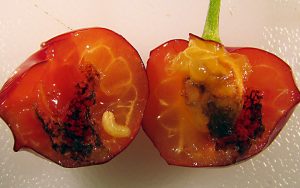
Western cherry fruit flies have been captured in Kaysville, UT, in the last few days. The traps are in an orchard with a very high population, so it is the earliest site that we see them active in northern Utah.
However, the time to treat for the “worms in the cherry” is based on the development of your own tree. Watch the fruit color. It will go from green to yellow, and then quickly develop a rosy blush. Once that rosy blush forms, then the female flies are able to penetrate the fruit skin and lay eggs inside.
Therefore, treatment should begin as soon as cherries develop a salmon-blush color. Base this off the fruits in the sunniest location of the tree, which is often toward the top or on the outside edges.
Western cherry fruit fly is a serious pest of tart and sweet cherries. Please keep in mind that any commercial growers’ crop can be rejected by the processing plant if worms are detected. Therefore, if you have trees that are adjacent to commercial orchards, it is important they are either treated for cherry fruit fly or removed, to preserve the livelihood of our tart cherry farmers.
Treatment Options – Backyard Growers
Start treatment at salmon-blush color and continue, with the last spray providing protection until harvest.
- Conventional:
- Malathion (malathion): every 7 days
- Bonide Fruit Tree Spray (carbaryl): every 14 days
- GardenTech Sevin, Spectracide Triazicide: every 14 days
- Organic:
- Fertilome / Gardens Alive / Bull’s Eye / Monterey (spinosad): every 7 days
- Safer BioNEEM (azadirachtin): every 7 to 10 days
Treatment – Commercial Growers
- Commercial growers, click here
BERRIES
Rose Stem Girdler
Adults are starting activity now and will be laying eggs on canes.
Rose stem girdler can attack raspberry, currants, black raspberry, and roses. Adults are small, bronze-colored, metallic beetles. The larvae can only be seen by slicing a cane lengthwise and looking it in the pith. As the larvae feed, the pith will be packed with dark-colored frass (excrement).
In late spring, females lay eggs near the base of the canes, and the larvae hatch and tunnel their way into the center cane tissue. Canes may have swellings at the feeding sites, and may break at weak areas later in the season. These canes will start to wilt and have scorched-appearing foliage.
Treatment
The best treatment option is to remove and destroy infested canes late in the season and over the winter. There are a few insecticides that can be used to kill the eggs and newly hatched larvae, but use caution when spraying flowering plants by treating at dawn or dusk only to protect pollinators, or ideally, do not spray plants in bloom.
- Options for commercial and residential include:
- Malathion
- pyrethrin (many brands)
- products containing a pyrethroid (Spectracide Triazicide, GardenTech Sevin, Asana, Mustang, Warrior)
- carbaryl
- Treat one to three times, spaced 7 to 14 days apart (depending on prior damage level and material used)

